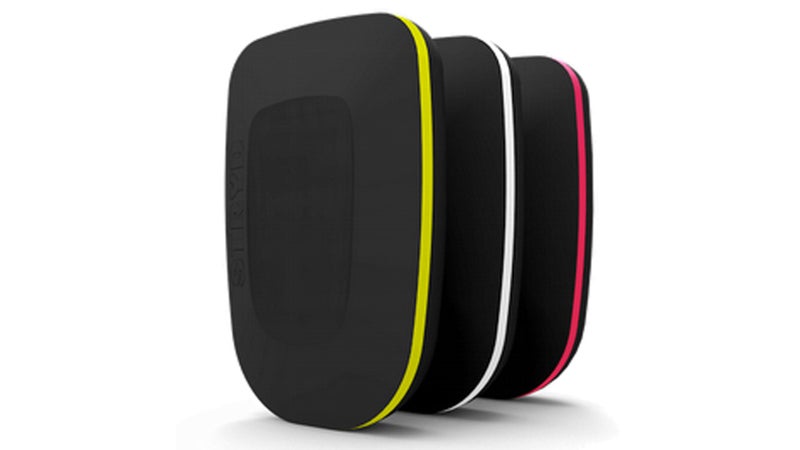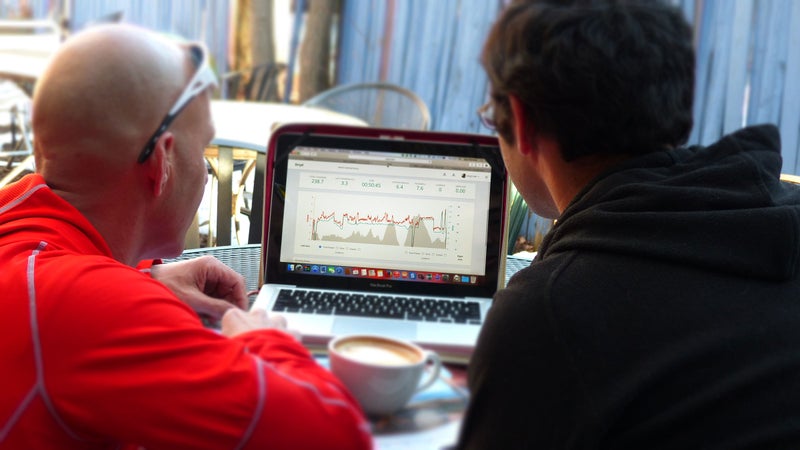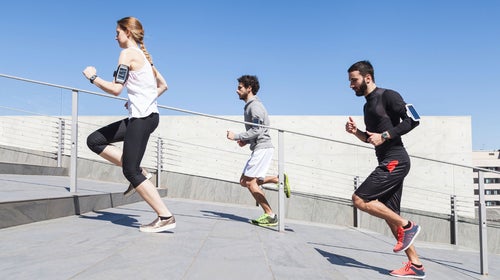When a╠řBoulder, Colorado-based╠řstartup╠řcalled Stryd launched its╠řKickstarter╠ř to pre-sell almost 1,600 of its prototype running╠řpower meters, it met its goal in just 12 days. ╠ř
ThatÔÇÖs high demand for a $150 product the running community doesnÔÇÖt yet know how to use. But hereÔÇÖs the thing: neither does Stryd.

Our “fundamental challenge right now is lack of knowledge,ÔÇŁ co-founder Li Shang says. Stryd relies on data for two essential needs:╠řto calibrate the software that powers it; and╠řto determine the value of a power number to╠řrunners. ÔÇťWe canÔÇÖt do that ourselves. We need the running community to help us,” he says.╠ř
That's a bit like a bike maker╠řcreating a brand-new prototype and asking its customers both how to ride it and whether it's any good. The running community╠řis tasked with╠řanswering╠řthe questions: What exactly is Styrd╠řfor? And do we need it?
Cyclists use power because itÔÇÖs an objective measure╠řof workout intensity that doesn't╠řdrift or vary. Heart rate is the response to exerciseÔÇöitÔÇÖs a valuable metric,╠řbut can change╠řbased on everything from how much training youÔÇÖve done to whether you had a beer╠řthe night before.╠řSo far, people have compared Styrd to a cycling power meter, but that's╠řan╠řultimately flawed╠řassumption.╠řThe two metrics are very different.╠ř

ÔÇťI didnÔÇÖt know anything about it at first, but I thought weÔÇÖd use it like a cycling power meter. ItÔÇÖs not,ÔÇŁ says , founder of D3 Multisport coaching, and USA TriathlonÔÇÖs 2014 Coach of the Year.
Ricci has used Stryd in limited testing with several athletes. He believes its biggest effect won't be on physiology, but on form and efficiencyÔÇötwo stats╠řthat╠řuntil now have been hard to quantify.╠ř
ÔÇťThink of a runner like a rubber╠řball,ÔÇŁ says Lim. Throw the╠řball down the road and╠řitÔÇÖll bounce efficiently, like a runner with great form. But throw the ball at a sharp╠řangle, and╠řyouÔÇÖll need to throw a lot harder to get that ball to travel the same speed as the first ball.
To understand that, you have to understand what╠řStryd is and what itÔÇÖs designed to measure. Cycling power meters operate╠řon the same basic technology: a strain gauge measures the deflection in a metal part, like a crankarm or wheel hub or pedal axle, in a mechanical system. In this case,╠řwe're talking about╠řthe drivetrain. By knowing the╠řproperties of the metal part and the system, you can correlate╠řthe amount of deflection with a level of force required to produce it. And velocity is cadence.╠ř
Then╠řyou plug those numbers into a╠řsimple equation:╠ř
force x velocity = power
Because cycling involves pushing pedals in a rigidly defined circular motion, metabolic efficiency differences between athletes are narrowÔÇöon the order of low single digit percentages. If you can do 300 watts on the bike,╠řchanging your pedal stroke to become more efficient╠řwon't make you ride any faster on the same amount of power.╠ř
Running╠řis a whole different animal.╠řSome athletes are far more efficent than others;╠řthey're able to run faster on less power.╠ř“The difficult part [about measuring╠řrunning power is]╠řthat thereÔÇÖs so much variability in how runners run,ÔÇŁ╠řsays Ewen North,╠řwho╠řoperates╠ř, a 500-odd member club of mostly recreational athletes in╠řBoulder, with his wife, Heather. ÔÇťThere are╠řdifferent stride lengths,╠řand body makeup,╠řand form, and they have to take all of that into account.”
That's where Stryd comes in.╠řIt╠řdoesnÔÇÖt measure force directly, says Shang. Instead, the╠řsmall pod clips to the back of a╠řrunnerÔÇÖs waistband. From there, a╠řcollection of sensors (mostly accelerometers) and a powerful processor measure acceleration and deceleration on a variety of axes. Stryd converts those forces of a runnerÔÇÖs forward motionÔÇöand her vertical motionÔÇöinto a similar, but subtly different, value they call running power, or center of mass power.╠řAnd this is the number that Stryd will allow you to train.
ThereÔÇÖs no power associated with forward motion in running, says Lim. In running, all power used comes in the energy we expend moving our limbs.
ÔÇťThink of a runner like a rubber bounce ball,ÔÇŁ Allen Lim, an advisor to Stryd, who helped develop the Powertap hub-based powermeter for cycling. If you throw a ball down the road, itÔÇÖll bounce along fast and efficiently, like a runner with great form. But if you throw the ball at the ground at a sharper angleÔÇöone that produces a higher arcÔÇöthen youÔÇÖll need to throw a lot harder (with more power) to get that ball to travel the same speed as the first ball.
The sensors in Stryd measure the force of that bounce. ÔÇťThe measurement is units of power, but itÔÇÖs a bounce meter,ÔÇŁ says Lim. ThatÔÇÖs both the deviceÔÇÖs strength and weakness: measuring that bounce gives runners instant feedback on changes they make to their form. But because itÔÇÖs measuring the runnerÔÇÖs various movements that make up that bounce versus a traditional power value youÔÇÖd get from a lab treadmill with a force plate, StrydÔÇÖs accuracy depends first on making sure it is accounting for all the movements that make up that bounce.╠ř
ÔÇťWe donÔÇÖt even have a product yet,ÔÇŁ Shang╠řsays. ÔÇťWe have a technology. We want that to be beneficial and help people to be better runners.
ItÔÇÖs easy to point out that runners and coaches already know that form is important. But traditional gait analysis and coaching only go so far in tweaking it. ThereÔÇÖs no way other than pace, subjective perceived effort, and the laggy, fickle heart rate number to measure the effect,╠řand thereÔÇÖs no constant feedback loop to ensure that changes in form are consistently applied.╠ř
But a single number that instantly changes when you drop your shoulders, or change your cadence, or lean forward a bit, closes that feedback loop. ItÔÇÖs a constant andÔÇöcruciallyÔÇöconsistent gauge of whether what youÔÇÖre doing is helpingÔÇöand how much. Combined with expert knowledge and coaching of the sort that╠řNorth possesses, and even a recreational runner could make, well,╠řbig strides.
How big? A well-known concept in running circles is running economy, which is essentially the amount of fuel a runner burns at a sub-maximal effort. A number of studies, dating back 30 years, find a 20 to 30 percent difference in running economy between . ThatÔÇÖs so large that some physiologists argue running economy is a better predictor of performance among elite athletes than traditional measures, like VO2 max. Running economy is down to a number of variables, from biomechanical factors like limb length to, yes, VO2 Max.╠ř
But a significant component is based in efficiency: things like cadence, vertical motion, and excessive upper body movement. Change those to become more efficient and, with time, your running economy can improve. ThereÔÇÖs a linear relationship between power and running economy, says Shang. If you can measure one, you can determine the other.
The net result, Ricci said, could be that running becomes more like swimming, another sport where strength and power take a backseat to form and efficiency. ÔÇťEvery swim workout my athletes do has some kind of skill-set or technique component to it,ÔÇŁ he says. ÔÇťAnd thatÔÇÖs not true in running. This may change that.ÔÇŁ
Stryd will almost certainly need refinement of its algorithms to improve accuracy. Shang says two of the areas the company is focused on are the effect of hills and headwinds, although the software currently does factor in both. And the flow of data will also help to more finely correlate center of mass power with running economy, since the relationship varies slightly depending on the runner.
But thatÔÇÖs what phase 2.0, when coaches start to get their Stryd units and test them, is designed to produce. With permission, Stryd plans to anonymize and publish all its data openly to invite more feedback and refinement. More important, it may start to realize, and quantify, some of the potential gains that can be made.
ÔÇťWe still donÔÇÖt know what will be the most important metrics,ÔÇŁ says Shang. Will they include , the proprietary measure of workout intensity that training software company Training Peaks developed? Some as-yet unnamed efficiency score? Something else no one can yet foresee?
If Shang╠řhas an idea, he wonÔÇÖt say. ÔÇťWe donÔÇÖt even have a product yet,ÔÇŁ he says. ÔÇťWe have a technology. We want that to be beneficial and help people to be better runners. But I still donÔÇÖt know that we have an answer.ÔÇŁ


